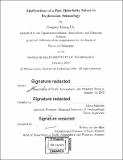Applications of a fast helmholtz solver in exploration seismology
Author(s)
Ely, Gregory Tsiang.
Download1102054340-MIT.pdf (19.62Mb)
Other Contributors
Massachusetts Institute of Technology. Department of Earth, Atmospheric, and Planetary Sciences.
Advisor
Alison Malcolm.
Terms of use
Metadata
Show full item recordAbstract
Seismic imaging techniques rely on a velocity model inverted from noisy data via a non-linear inverse problem. This inferred velocity model may be inaccurate and lead to incorrect interpretations of the subsurface. In this thesis, I combine a fast Helmholtz solver, the field expansion method, with a reduced velocity model parameterization to address the impact of an uncertain or inaccurate velocity model. I modify the field expansion framework to accurately simulate the acoustic field for velocity models that commonly occur in seismic imaging. The field expansion method describes the acoustic field in a periodic medium in which the velocity model and source repeat infinitely in the horizontal direction, much like a diffraction grating. This Helmholtz solver achieves significant computational speed by restricting the velocity model to consists of a number of non-overlapping piecewise layers. I modify this restricted framework to allow for the modeling of more complex velocity models with dozens of parameters instead of the thousands or millions of parameters used to characterize pixelized velocity models. This parameterization, combined with the speed of the forward solver allow me to examine two problems in seismic imaging: uncertainty quantification and benchmarking global optimization methods. With the rapid speed of the forward solver, I use Markov Chain Monte Carlo methods to estimate the non-linear probability distribution of a 2D seismic velocity model given noisy data. Although global optimization methods have recently been applied to inversion of seismic velocity model using raw waveform data, it has been impossible to compare various types of algorithms and impacts of parameters on convergence. The reduced forward model presented in this paper allows me to benchmark these algorithms and objectively compare their performance to one another. I also explore the application of these and other geophysical methods to a medical ultrasound dataset that is well approximated by a layered model.
Description
Thesis: Ph. D., Massachusetts Institute of Technology, Department of Earth, Atmospheric, and Planetary Sciences, 2019 Cataloged from PDF version of thesis. Includes bibliographical references (pages 141-150).
Date issued
2019Department
Massachusetts Institute of Technology. Department of Earth, Atmospheric, and Planetary SciencesPublisher
Massachusetts Institute of Technology
Keywords
Earth, Atmospheric, and Planetary Sciences.